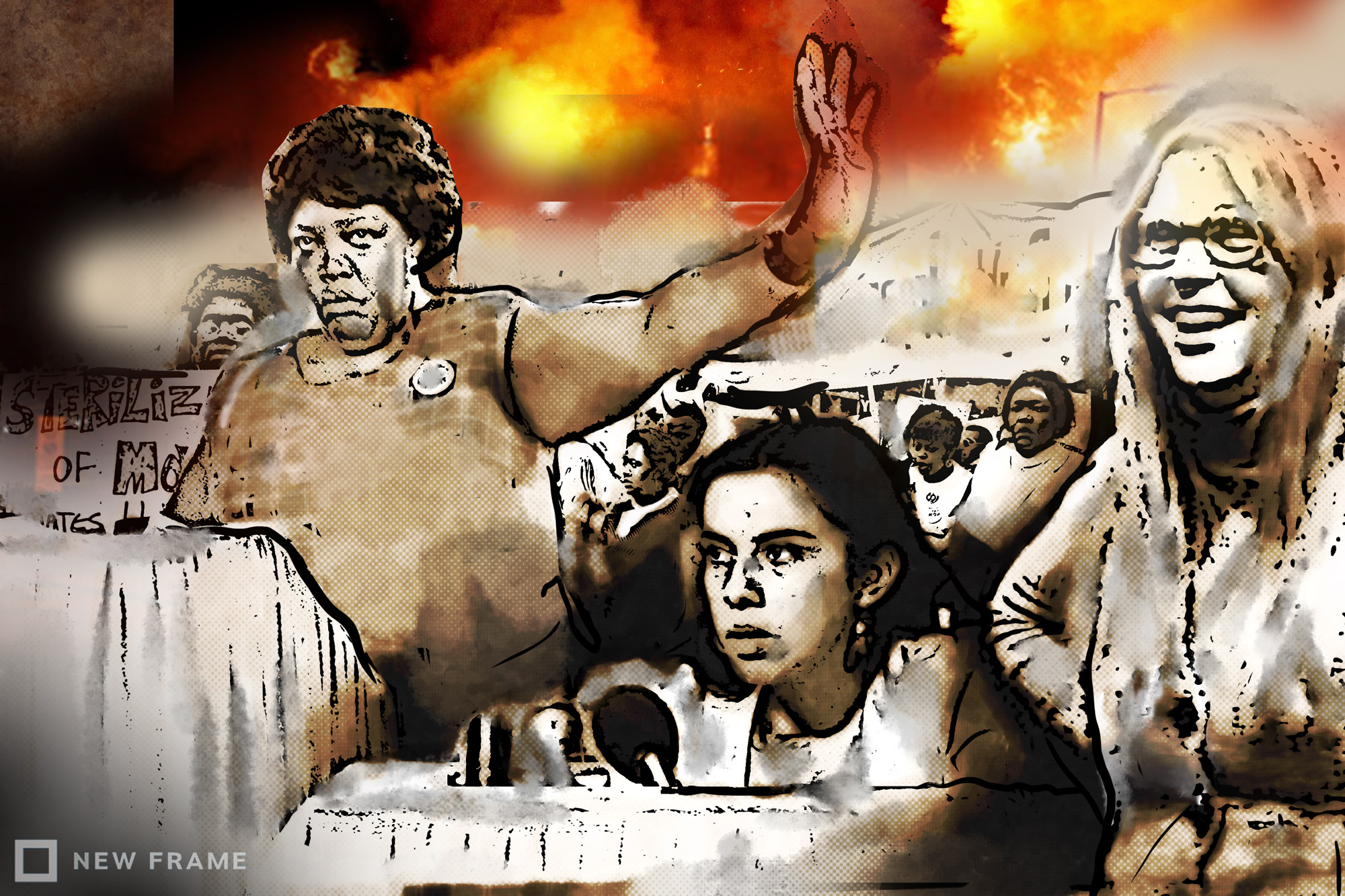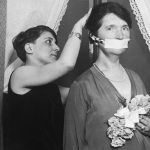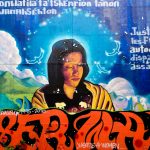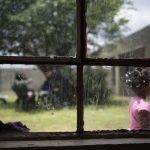New Books | Set the Night on Fire: LA in the Sixties
This 800-page history covers the resistance movements that swept through Los Angeles in the 1960s. In this excerpt, women fight for reproductive rights and fair treatment when receiving welfare.
Author:
6 May 2020

This is an excerpt of Mike Davis and Jon Wiener’s Set the Night on Fire: LA in the Sixties (Verso Books, 2020).
The many faces of women’s liberation (1967-1974)
On 20 September 1972, seven Los Angeles Police Department (LAPD) officers and three state medical examiners raided the Women’s Self-Help Clinic on Crenshaw Boulevard. They had warrants for the arrest of two staff members, Carol Downer and Colleen Wilson. The charge: practicing medicine without a license. The women weren’t there; the police seized rubber gloves, syringes, IUDs, hypodermic needles, menstrual extraction devices; equipment for blood tests, Pap tests, and urine analysis; and patient charts and records. The warrants charged Carol Downer with “diagnosing a women’s illness as a yeast infection and treating it with yoghurt.” Colleen Wilson was charged with 11 counts, including “performing a menstrual extraction, giving pelvic examinations and testing for pregnancy”. The right of women to know their bodies had been declared illegal by law enforcement officials.
Feminist activist and author Barbara Ehrenreich explained the origins of this movement: the “humiliation and helplessness” women felt when doctors called them “difficult” for “asking questions”, or diagnosed them as “neurotic” for “possessing a symptom for which the doctors did not yet have a disease”. She remembered the “secrecy and shame” – and then the excitement of hearing that two Los Angeles women, Carol Downer and Lorraine Rothman, had taught themselves to do cervical self-examinations, and that Downer was starting the first Feminist Women’s Health Center. “It began to seem possible,” she recalled, “that, with enough organising, studying, and – especially – sharing, we might just achieve “the right to control our own bodies”.
Carol Downer’s defense became a national cause célèbre. Her supporters included Congresswoman Bella Abzug, Gloria Steinem, Robin Morgan and Dr Benjamin Spock. The prosecution case rested on the testimony of three undercover agents who had gone to the clinic posing as patients – two female LAPD officers and a high school guidance counsellor. The clinic collective decided that Wilson, who had so many charges against her, should plead guilty, and Downer should demand a trial, where the case for women’s self-help could be presented to a jury. Wilson made a deal, pled guilty to one count, and was sentenced to a fine of $250, 25 days in jail (suspended) and two years of probation.
In the campaign leading up to the trial, Downer argued that the centre “does no more than teach vaginal self-examination … We don’t diagnose and we don’t treat,” she said. “We’re in health education … We realise that women do not know their own bodies and haven’t been given the kind of information they need to take care of themselves.” The investigator for the state’s department of consumer affairs replied that “the case has nothing to do with women’s liberation”.
Related article:
The trial lasted for five days, and the courtroom was packed every day. Downer’s supporters gleefully called it “the great yoghurt conspiracy”, pointing out that the police had seized, among the other items, yoghurt from the refrigerator. Medical experts for the defense testified that yoghurt was used to cure yeast infections “because bacterial agents in the dairy product work to combat bacterial agents spawned by the yeast infection”. Downer’s attorneys, Diane Wayne and Jeanette Christy, argued that “application of the home remedy was no different than applying eye drops to an eye infection or a Band-Aid to a bruised knee”. The deputy city attorney of LA replied, “Who are they to diagnose a yeast infection and prescribe yoghurt for it?” Everything they were doing at the centre, he said, should have been done by a physician.
The jury – eight men and four women – found Downer not guilty. Women’s self-help had won a huge victory. The trial and verdict also galvanised local feminists. One wrote, What man would be put under police surveillance for looking at his penis? What man would have to spend $20 000 and two months in court for looking at the penis of his brother? This case is a clear-cut version of the position of women in America – the lengths to which we must go and the obstacles which must be overcome to be free.”
As the women’s self-help movement grew, historian Ruth Rosen explains, “male doctors became proxy figures for all male authority”. Women refused to be passive patients, learned to be assertive and to do their own research. As a result, the women’s health movement “turned women into feminists”.
The year after the Downer trial, in 1973, Simon & Schuster published Our Bodies, Ourselves by the Boston Women’s Health Book Collective – featured at first at places like Sisterhood Bookstore, founded in 1973 in Westwood by two sisters-in-law, Adele Wallace and Simone Wallace. Within a few years, the book became a national bestseller. 1973 was also the year the Supreme Court issued its ruling in Roe v Wade. The course of history had changed over the space of a couple of years.
Chicana feminism
Meanwhile, a different kind of battle over women’s health was underway, with a different constituency: instead of a fight for abortion rights, it was a fight against forced sterilisation; and instead of a mostly white constituency, this movement was mostly Chicana. But the underlying issue was the same – women’s right to control their own bodies.
“Eleven Latin Women File Suit on Sterilization” read the page-one headline in the LA Times; “Claim They Were Coerced or Deceived into Having Operation at Medical Center.” The case was a shocker: Dolores Madrigal, a married mother of two who didn’t speak English, said she told the doctor and nurse and County-USC Hospital “no” when they suggested in 1973 that she submit to sterilisation. “But then, under the severe pain of labour, she said, she signed the consent form” – after being “assured that ‘the operation could easily be reversed.’”
There were more: Rebecca Figueroa said that in October 1971, when she went to County-USC to deliver her baby and was bleeding profusely before delivery, nurses told her that “birth control pills caused her sickness and that sterilisation was the only alternative to death”. She signed the consent form. Maria Figueroa said that she refused to have her tubes tied in June 1971, but in the delivery room and subjected to “repeated solicitation and pressure”, she agreed – “provided the baby delivered was a boy” – because she already had a daughter. It was a girl, but the doctor performed a tubal ligation anyway. A total of 11 women told similar stories.
The court case had been preceded by more than a year of organising, demonstrations and publicity, organised by the leading Chicana feminist group in California, the Comisión Femenil Mexicana Nacional. It held its first conference in 1973 in Goleta, outside Santa Barbara. More than 800 women participated, representing farmworkers, garment workers, trade unions, college campuses, grassroots communities and professional groups. One of the key organisers of the Comisión, and later president, was Yolanda Nava, who had been a leader of MEChA at UCLA. The Comisión, Nava later explained, “focused on grassroots activism in poorer communities … rather than consciousness-raising”. Their first projects involved childcare, job training and a rape hotline. And they discussed abortion, which members regarded as “a fact of life” and “a personal decision”. That was a controversial position within the Chicano movement, where Cesar Chavez and other male leaders argued that “smaller families would only diminish the numerical power of the poor” and that “the race” should “multiply” in order to “progress”.
But the group’s biggest and best-known effort was a campaign to stop forced sterilisation. It began in 1973, when Bernard Rosenfeld, a medical resident at County-USC General hospital, had gone to the Center for Law and Justice, a legal aid center in LA, with confidential hospital records documenting forced sterilisation. Antonia Hernandez worked at the centre – she had just graduated from UCLA Law School – and, along with attorney Richard Navarette, she set out to find the women in Rosenfeld’s documents, hoping to recruit plaintiffs for a class action suit. The attorneys for the class decided they needed an additional plaintiff – a larger group of women who received medical care at County-USC. They turned to the Comisión as the organisation that could represent that class of Latinas. Comisión President Gloria Molina and Antonia Hernandez, from their base at the Comisión’s Chicana Services Action Center in East LA, raised funds, organised demonstrations and distributed press releases to the media.
Related article:
When the case was finally filed in 1975, the Times ran a story featuring a photo of two women: a stern and determined Gloria Molina and a tearful Dolores Madrigal. The judge eventually ruled in favour of the doctors and the hospital, but the Comisión had won the political fight: the governor and the state legislature strengthened protections against unwanted sterilisations, providing for consent forms in languages other than English, a 72-hour waiting period for patients under 21 and a requirement that women be informed that their welfare benefits would not be terminated if they refused sterilisation.
The Madrigal case “galvanised an emerging Chicana feminist movement”, says historian Vicki Ruiz. And it drew some lines between men and women activists. But the women led this fight and defined the issues. While these battles over women’s health were being fought in Los Angeles, other strands of the new women’s activism also emerged in LA, with distinct constituencies and issues. The earliest, beginning in 1963, was welfare rights organising among black women in public housing.
Welfare rights organising
Black women’s organising in LA in the 1960s has its own history, beginning in Watts with the remarkable Johnnie Tillmon, who helped found the first grassroots welfare mothers’ organisation in the country. She explained what it was about in a memorable article in Ms magazine: being on welfare, she said, was like being in a “supersexist marriage”. “You trade in ‘a’ man for ‘The’ Man,” she wrote. “But you can’t divorce him if he treats you bad. He can divorce you, of course – cut you off – any time he wants. But in that case, ‘he’ keeps the kids, not you. ‘The’ Man runs everything. ‘The’ Man, the welfare system, controls your money. ‘He’ tells you what to buy and what not to buy, where to buy it and what things cost … In ordinary marriage, sex is supposed to be for your husband. On AFDC [welfare] you’re not supposed to have sex at all. You give up control of your body. It’s a condition of aid.”
Johnnie Tillmon was born in Arkansas in 1926 to a family of sharecroppers. She left her husband behind when she moved to California in 1960 as a single parent with six children. She got a job in a laundry – doing work she had done in Arkansas – and became the union steward for Local 52 of the Laundry and Dry Cleaning Workers Union. She applied for welfare in 1963, she later said, so she could stay home with her children, the oldest of whom had been skipping school while she was at work. She joined the community group in the housing project in Watts where she lived, the Nickerson Gardens Planning Organization – Nickerson Gardens was the largest public housing project west of the Mississippi, with 1 054 units. She also became active in local politics, working to elect Augustus Hawkins as California’s first black member of Congress in 1962.
The turning point for Tillmon came one Sunday when she heard a neighbourhood churchgoer disparage women on welfare as lazy. She organised six women to go to the managers’ office to complain, and there, she says, she “noticed a stack of folders on his desk marked ‘ANC’, identifying the women in the housing project who were receiving welfare”. (Aid to Needy Children was the official name of the welfare programme.) The manager agreed to give them the list, and they talked to more than 300 women – and formed an organisation they called “ANC Mothers Anonymous”. It was the first organisation of women on welfare in the nation, and it was all black. It was “anonymous” because they didn’t want their social workers to know they were members.
Related article:
And, they demanded respect from caseworkers. The ANC Mothers quickly gained supporters throughout Watts. LA’s first black TV journalist, Louis Lomax, featured Tillmon and her work with ANC Mothers on his show – the beginning of her rise as a national figure. Similar groups of welfare mothers soon formed in the Bay Area, and others in other parts of LA. The groups formed the California Welfare Rights Organization, with Tillmon as the group’s first president. At an April 1966 conference in Washington, DC, she declared, “When the poverty programme is over, the rich will be rich, the poor will be poor, and I will still get a welfare check.” That got national publicity, and when Tillmon and women from welfare rights organisations in other states formed the National Welfare Rights Organization in August 1966, she became a national leader.
Then Republicans, led by Ronald Reagan (then a candidate for governor), started attacking welfare recipients, calling them “welfare queens”, as the centrepiece of their campaign (along with attacks on Berkeley’s Free Speech Movement). Reagan won the election that November. The battle lines had been drawn. While much of the national welfare rights movement focused on defending the right to public assistance, Johnnie Tillmon had a different political agenda: poor women, she argued, needed training to get good jobs so they could support their children, and they needed childcare. She never wanted poverty programme funding for ANC Mothers Anonymous and relied instead on private fundraising. Also, while ANC Mothers Anonymous was a black group, Tillmon thought black and white poor women should belong to the same organisation. She also welcomed lesbians to welfare rights groups. She always said the struggle for welfare rights was not between women and men, but between women and “The Man”.
Related article:
At first, ANC Mothers Anonymous worked to help women who were denied assistance or who wanted to complain about their social workers – especially about midnight raids on their apartments, where social workers searched for men staying the night. Any woman on welfare found with a man would not receive a check that month. The group also “tried to help people being evicted, people not being able to get all their aid, people being cut off for whatever reason”, Tillmon later explained. “We began finding out that we could appeal. A lot of people were afraid to. We encouraged folk, if what you need is not met, then these are the places that you write to. And then we found out that we could go with the recipient to ask for a fair hearing. We developed some resources where we could contact a person, maybe on the board of supervisors, or a person in the top administration, because most of your trouble comes from down at the bottom.”




